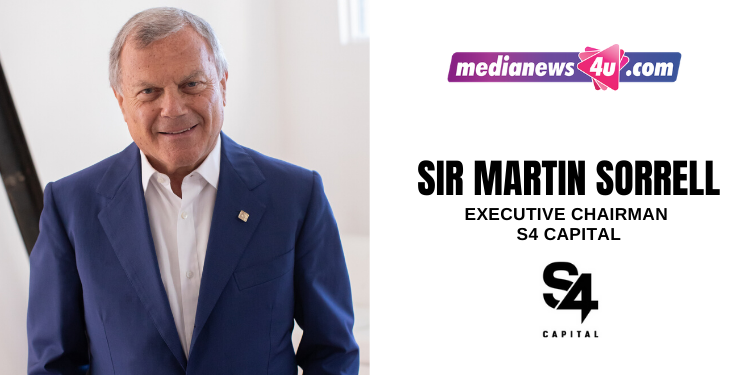Sir Martin Stuart Sorrell is arguably the best-known name worldwide in the media, marketing and communication space. He is known to be one of the most brilliant, irrepressible and outspoken evangelists and thought leaders across the traditional and now the digital. His contributions and global impact have not only been phenomenal, but also, we daresay, unmatched.
Sir Martin created and grew the WPP group to make it the world’s largest advertising and communications group by both, revenue and staff strength, and by 2017 had become the world’s longest-serving CEO of an FTSE 100 company. And as soon as he retired from the WPP group in April 2018, Sir Martin decided to focus on digital and promptly set about creating a digital powerhouse that found its origin in Derriston Capital. Ever since, we have seen it grow into the purely digitally-driven marketing company, S4 Capital.
Yohan P Chawla caught up with Sir Martin Sorrell for a lengthy conversation on virtual meeting.
It was a conversation that was as lengthy as it was rewarding for its deep insights and wisdom. Sir Martin shared his views on several important areas: the COVID-19 pandemic and its impact on the business of the marketing and advertising industry which has witnessed tremendous disruptions across the landscape; the amount of time the industry will take to bounce back across sector-specific V-, U- and L-shaped recovery models; the extremely bright future of the model of the future, Digital, and his belief in the power and potential of S4 Capital. Which he credits to the fact that it has no traditional or analogue business unlike WPP which still dominates in India the old way. S4 Capital, Sir Martin says, will dominate India in the new way.
All this, and much more. Read on.
While the importance of digital as an integral part of the business of marketing is a firmly established truth, how has Covid-19 reinforced afresh – if you think it has — the importance of digital, and to what extent?
I don’t know about being reinforced afresh but I would say that it has accelerated the adoption of digital technologies, transformation and disruption at three levels.
Among consumers
First, at the consumer level. Consumers in India and elsewhere are communicating online, just as you and I are, right now, and that’s affecting the way people communicate. People are educating their children online with companies like Zoom, for example.
In USA, one-third of households are trying for the first time to use online shopping for groceries and essentials. In India, Facebook’s investment in Mukesh Ambani’s Jio along with a number of others, are emphasizing the importance of online shopping.
In India that’s a very important development because of the number of people that derive their living at a retail and wholesale level. It’s important economically, it’s important politically, it’s important to Prime Minister Modi, it’s important to Mukesh Ambani and it’s important to Facebook that retailers continue to survive and prosper. Opening up of Facebook shops or the equivalent of that in India will be a great move.
From a media point of view
Second, from a media point of view, as you well know as we’re conducting this interview online. I just was fixing a session with BMT Australia for next Monday for Cannes online, which they’re doing digitally. Media is being affected; the impact on newspapers and magazines has been huge; we have seen Rupert burn off his clothes with more than 100 titles.
In Australia, the Australian Communications Commission is threatening to tax or fine Google and Facebook because of the impact they claim on local news. What’s happening within the EU and with the DOJ in America, obviously newspapers and magazines are under extreme pressure and the pressure on them was accelerated with the rise of the streamers such as Disney+ and Netflix.
Disney+, in the process of launching, has acquired more than 50 million users, which is probably one of the most successful new business launches that we’ve seen.
Taking outdoor for example and especially the general outdoor which is a small part of the market in the Indian context; it is under pressure. The use of digital technology on outdoor is growing rapidly. You see CNN free-to-air television is coming under great pressure as the streamers improve. It’s affecting media, which are accelerating the adoption of digital media.
Newspapers and magazines, in my view, will have to move to content that is provided by subscription and supported with advertising revenue. So you will get a model that will become increasingly important with enterprise digital transformation.
Status quo now truly disrupted
Enterprises which were concerned before about disturbing the status quo have no status quo to disrupt anymore. The status quo is now disrupted, truly disrupted. For example, BP Oil has said that they are going to restructure the company, they’re reducing their numbers administratively by 10,000. And thinking a $13 billion to $17 billion write-off assuming a price of oil of $65…what we are starting to see is that businesses are restructuring their businesses. And a vital and probably the most important part of that is that they are digitally transforming them or transforming them faster. Before, they were hesitant to make the transformation because they didn’t want to disrupt a business that was going okay and not brilliantly. Now, they have no choice. I would say, they’re using… as people say — never waste a crisis. They’re using the crisis as a means of restructuring their business, without fear of being put under excessive pressure.
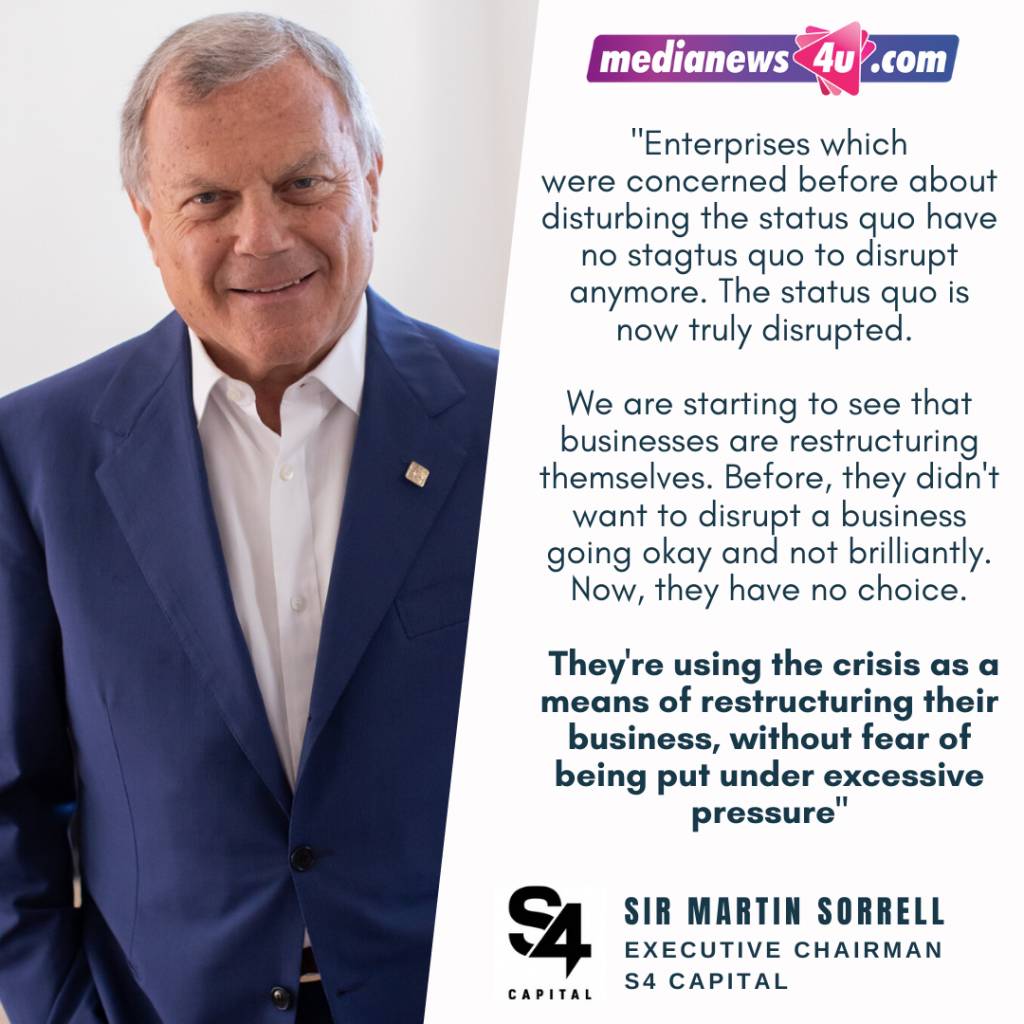
How do you, as a respected thought leader worldwide, plan to leverage digital for S4 Capital globally?
Well, it’s right to our wheelhouse or to our sweet spot, because S4 has no traditional or analogue business unlike the holding company for example WPP, which still dominates in India, the old way.S4 Capital will dominate India, in the new way.
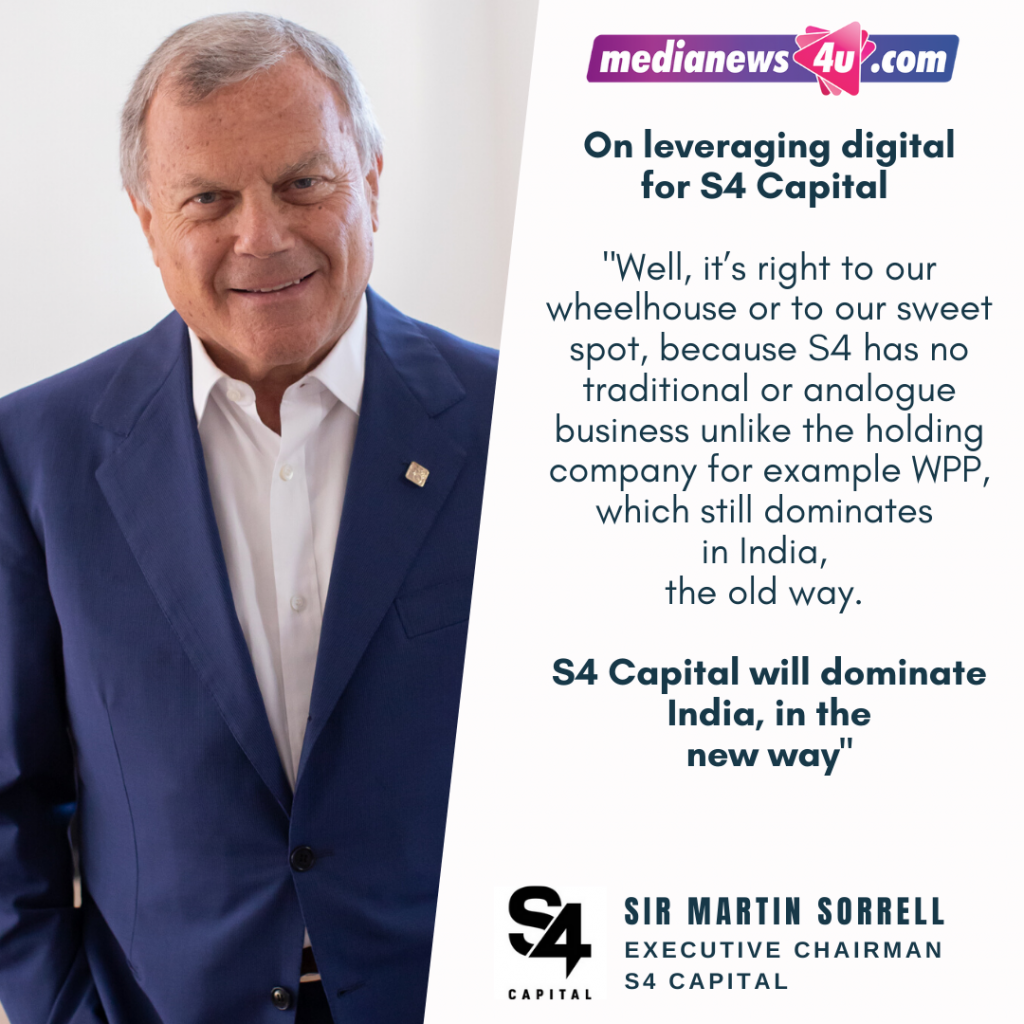
The second-largest advertising, marketing services’ holding company is Omnicom, which is bigger by market cap, but as a shareholder I am disappointed about it. The fact of the matter is that they’re going backwards. The reason they’re going backwards is because they have an analogue business with the weight of an albatross around their neck.
S4 is a model for the future
While at S4, at some point in the future — say in about five years’ time — we too will have to look at where we want to take the business forward, because a lot of the things that we’re doing now will become old hats as technology advances even more rapidly.

As everybody says the pace of technology advancement increases and that’s why S4 Capital has no baggage; it is a digital business because that’s where the growth is. It has a model, based on first-party data, which we’ve been mixing with third-party cookies by Google and Apple. It’s the basis for driving the creation of digital advertising content, and distributing it through data along with analytics and programmatic media. The model at S4 is a model for the future.
Our mantra is that we go to market as faster, better and cheaper. The quantity value of faster speed is about agility, better is about understanding the digital ecosystem. Understanding Amazon, Facebook, Google, Tencent, Alibaba, Tik-Tok, Apple, Microsoft, Adobe, Oracle, Salesforce, IBM, SAP, Baidu, Pinterest, Snapchat, Netflix, Spotify and Samsung…so really understanding how they function. Cheaper is about efficiency it’s not about zero-based budgeting anymore, it’s about branding and innovation, but it’s understanding about the need to be efficient.

A simple unitary structure
We have a simple unitary structure and we don’t have conflicting silos. What we have is a content business around MediaMonks, a data and programmatic business around MightyHive. We’re combining the two increasingly so we have a really good balance of business. We’re not enormous yet but we have a market capitalization of $1.5 billion, which, when you think about the fact that we have come from zero in about 21 months ago is outstanding; and that’s a great tribute to our 2550 people who are spread across 30 countries.
We’ve made a very good start, a fast start and the race is in its early stages and we’re doing very well. Yes, the holding company is in most of the competitions, if not all of them, and we take business away from them.
In these newer areas of businesses that are dominated by these tech companies, we do very well. Over 50% of our business comes from tech companies so we’re very much a tech-led model.
What are the new focus areas, and any redundancies in the digital marketing space, that have come to the fore for you during the past three or four months?
Economists at Morgan Stanley are saying that there will be a ‘V’-shaped recovery by Q4 of 2020; you know, my view, consistently throughout the crisis, has been that we will see a Q3 better than Q2.
As everyone saw in our AGM statement, our topline has grown by 17% in the first four months, which is very different to the picture that we hear and see from the holding companies. For example, it is more akin to what we see from the technology companies. The market tends to think of S4 as being a tech company more than a company that provides advertising and marketing services.
But having said that, I think Q3 will be better than Q2 relatively, and Q4 better than Q3. We should be back I think the way we were in 2019, by the end of 2020, or into the early stages of 2021.
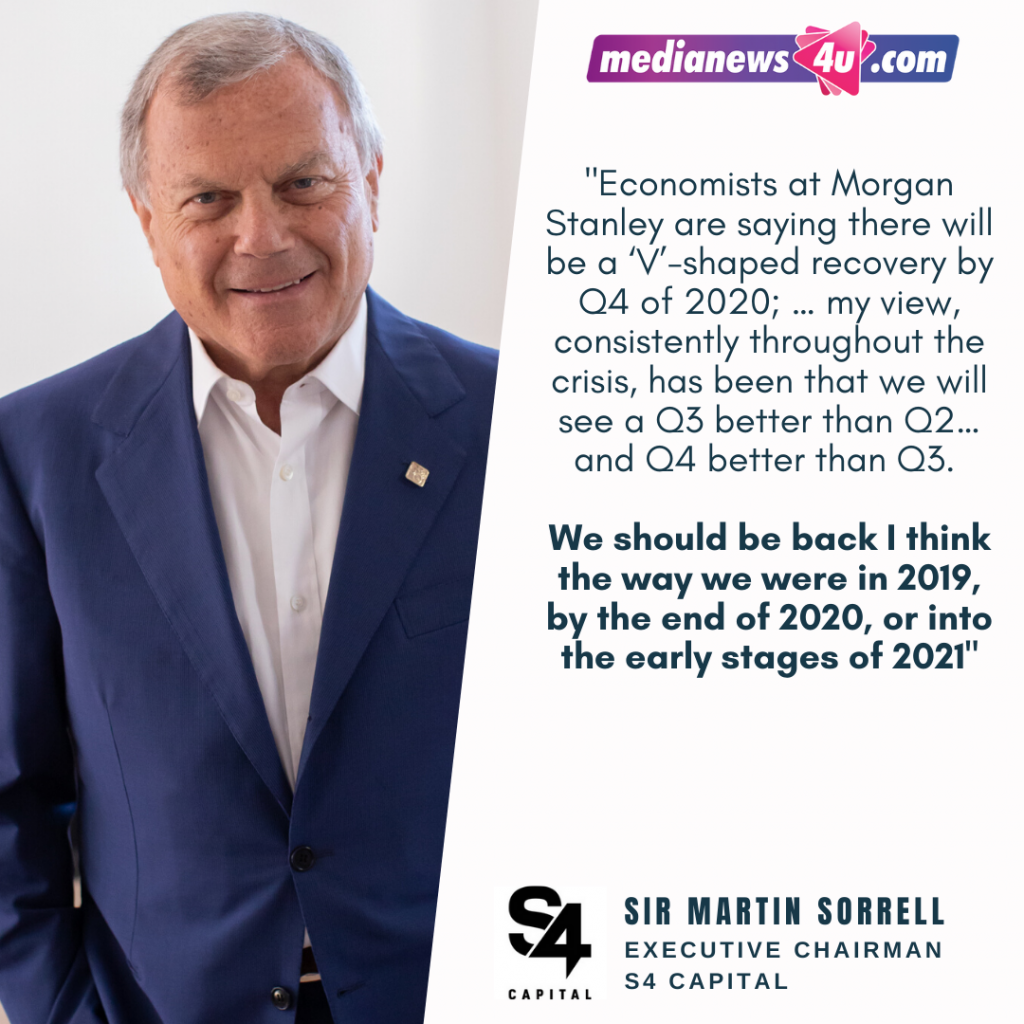
There are going to be areas of the economy that are more ‘V’ shaped. We’re very focused on online shopping. Look at the results of H&M — their sales are down by 50% but their online sales are up by one third, so focusing on online shopping, that’s obviously a focus area.
Healthcare really has not missed a beat during COVID-19 which you would expect because it obviously plays to the strengths of the healthcare companies, so healthcare is another vertical. Entertainment and gaming I would say those are the four areas that we’re very focused on.
Packaged goods companies tend to be more spotty and Proctor & Gamble had a record first quarter and because they have a more food portfolio around to service including ice creams, they were bound to be more challenged. L’Oreal, much more focused around haircare and cosmetics and despite the fact that they lost obviously their in-store distribution and demonstrators, have done very well online,and Colgate too has done very well. Packaged goods will be more ‘U’ shaped.
It’s interesting to see the moves by the Chinese in the auto industry. Tencent Auto has made a bid for a US-based company. They seem to be getting a bargain given what’s happening in the Chinese auto space, they’re more ‘U’ shaped around autos.
The ‘L’ shape categories which tend to be travel and hotel. It struck me by a conversation with the head of a global hotel chain, head of global airline and the head of global fast-food restaurant company. The Hotel head said that we’ll get back to booking hotels; the airline head said, we’ll get back to booking an airline and the head of the fast-food restaurant company said that they’ve travel budget for zero and it will not go back to more than 50% of what it was earlier.
We are getting to see without doubt, certainly in the short- to medium term and maybe even in the long term, a drastic reduction in the amount of travel — I mean, where you and I are communicating this way, much as I love coming to India, in the future I won’t do trips for one day or two days or three days. I will do longer trips and spend a week or two and concentrate the activity rather than travel across the world at the drop of a hat. I feel better for it, you know, mentally and physically better for not having to travel at the drop of a hat. So that is my view of how S4 should be looking at things now.
How has S4 Capital been helping its clients navigate through COVID-19 with special reference to their business and communication strategies and priorities? What have been your new learnings, and what role did your relationships with your clients play during the crisis?
I think in the initial phase of the pandemic, we obviously saw the impact on Asia Pacific, on China in particular Q1 back in February. 70% of our businesses are in America and South America, 20% of it are across Western Europe, and we really saw a factor COVID-19 in the month of April, or it only affected at the back end of March. I think April for us was the troughs with receiving money to improve and we had the initial indications on June, which were a little better than the month of May. I think we are coming out of the troughs.
What we saw in the end of March was a paralysis. And then into April, we saw two distinct patterns forming — the first was with the tech companies by and large maintaining their levels of spending or were close to it. They didn’t cut much and they moved money from LIVE sporting events, for example, the Olympics which didn’t take place as scheduled in 2020, or basketball or the Premier League, or the IPL, etcetera. They moved money to purpose campaigns, understandably, but they were, I think, cautious because every service campaign almost looked the same. If you see their logos or the names of the companies you wouldn’t know who was doing the advertising or who was supporting the purpose campaign…for the frontline workers or police or fire-fighters, etcetera.
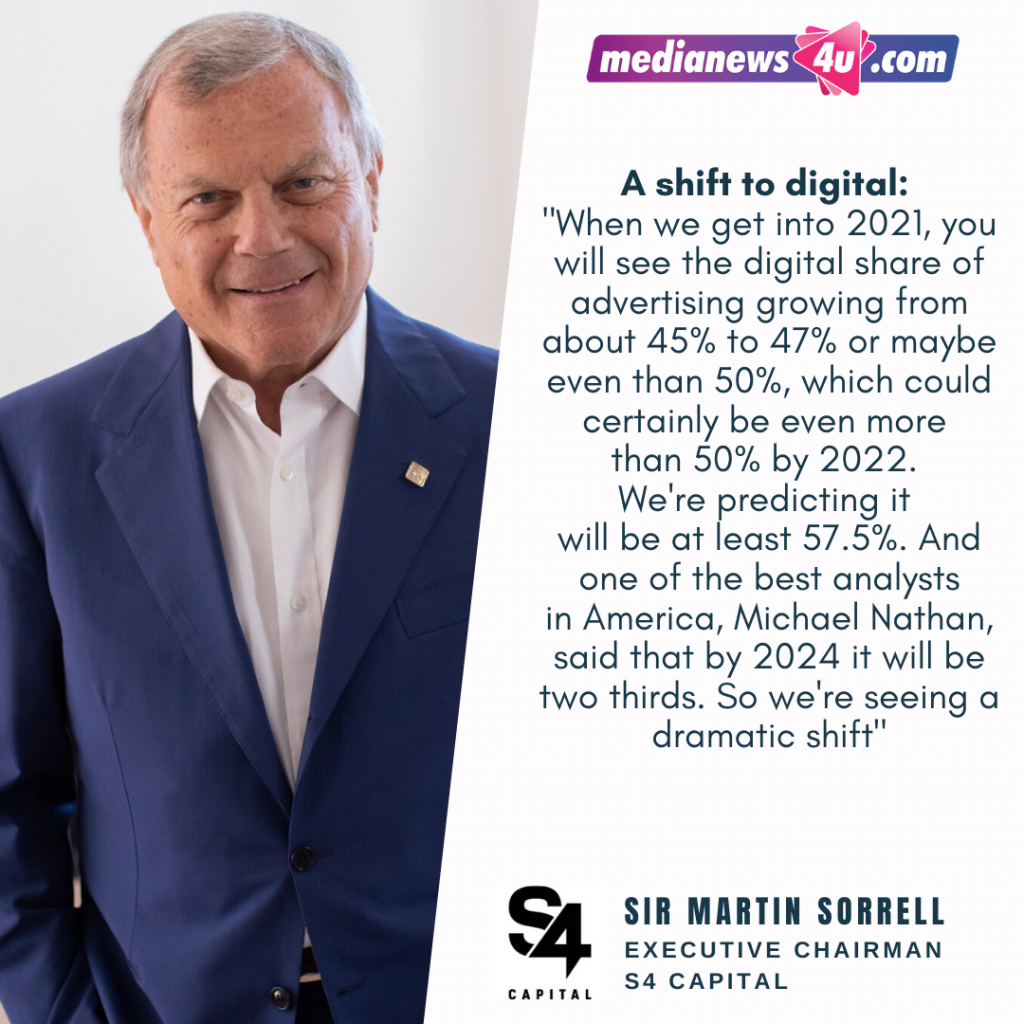
So what you saw was the tech companies maintaining their spends or shifting money. And CMOs doing deals with the CFO saying, we’ll shift money from the first half to the second half of the year.
On the packaged goods healthcare, retail, and other categories, we saw more cooking and for sale, but with the first bucket what we saw across both tech and CPG healthcare, and retail, was a shift to digital I think, when we look at 2020. In total, when we get into 2021, you will see the digital share of advertising growing from about 45% to 47% or maybe even than 50%, which could certainly be even more than 50% by 2022. We’re predicting it will be at least 57.5%. And one of the best analysts in America, Michael Nathan, said that by 2024 it will be two thirds. So we’re seeing a dramatic shift.
Much tighter relationships with clients
I think relationships with clients or relationships within our firm are much tighter and much closer. We moved very quickly to looking at content for example, around animation. We saw an explosion in interest in animation for the obvious reasons with robotics studios. We purchased a robotics studio in Amsterdam called Caramel Pictures.
Last year, we joked that we were acquiring more robots than people and it was proven to be not only true, but valuable in the sense of Covid-19. We have established very strong revenue streams by shifting events from live experience, to online experience. What people don’t understand is that a large number of the tech companies sell their products or services and licenses through live events. Switching those live events to online is becoming more and more important in developing a business umbrella.
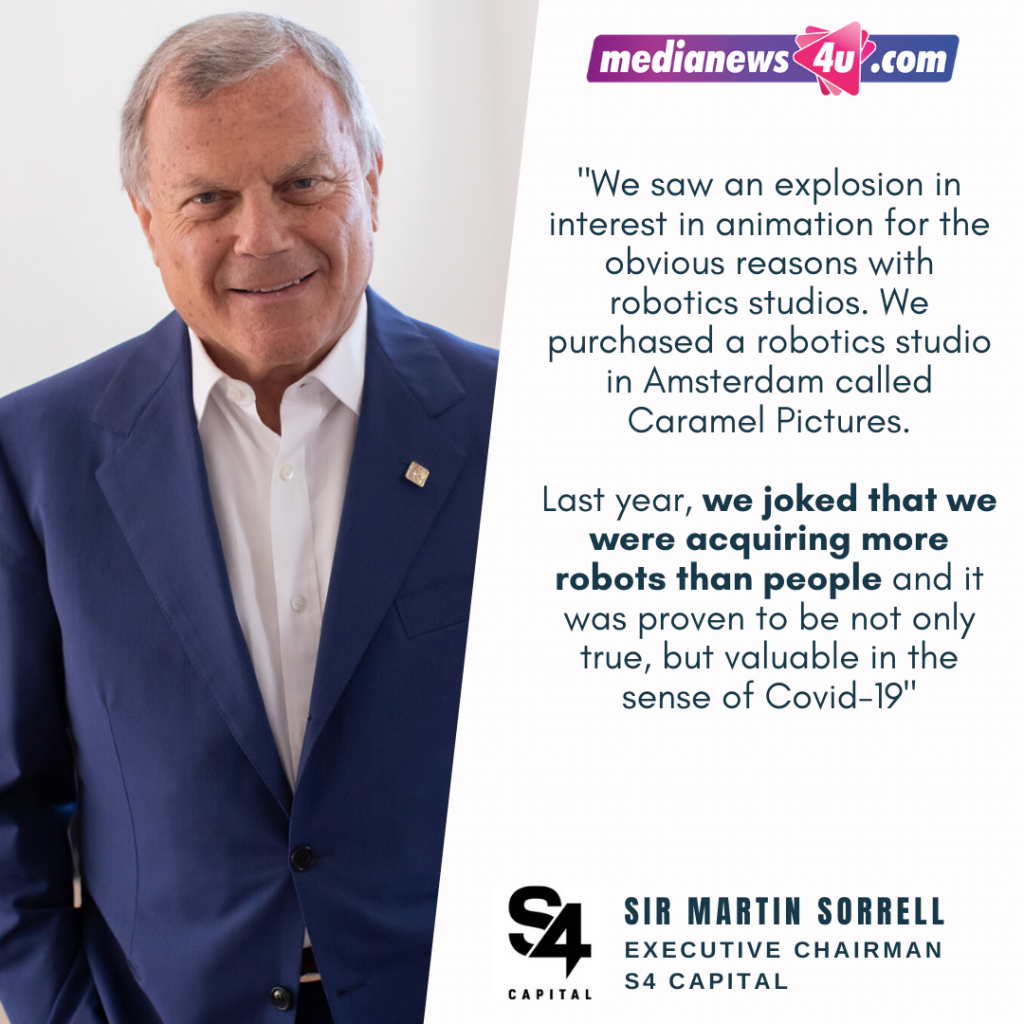
The WFH ‘shift’
We’re a digital business and we managed to shift. Working from home has become more important to our people who are digital natives; they are not even digital-first. The average age of the 2000 people in content is about 30 to 33, and average age of the more than 550 people under MightyHiveis about 25, and they are more accustomed to working from home. They work 24/7 in a 24/7, always-on environment. So it was no change for them.
En-route to hybrid model
What we’re seeing coming out of the lockdown is that we’ll move to a hybrid model. We have cancelled a number of our leases in London and New York. We are 560 people in California with 550 people in Holland and Amsterdam, and we’re moving into fewer and fewer buildings with different footprints and encouraging if our people want to work from home with flexible commuting time. So we’re having a much more flexible model.
What’s your view on how the Indian brands have been doing during COVID-19?
Indian brands have done a good job of their communication plans, so there is a danger that it becomes too formulaic and it becomes insincere. I think what consumers want and you see it also with the Black Lives Matters movement which I think is a very different movement rather like the new series but I think the black box movement will secure change and not only access to racism, education and training, but also there will be significant actions or they’re already significant actions in result, there will be legislative and financial actions that will alleviate the issues and the problems.
In our own case, we’ve established a donation program of US$250,000. We’re a small company, but that’s equivalent to WPP putting together under $10 million, and I would challenge them to do the same.
Our mission really is to create a new era here – an advertising and marketing services company, a tech-led one; but the subsidiary of that is to create employment opportunities at a time when Forrester Research says the holding companies will eliminate 15,000 jobs. We’re trying to create jobs, there will be a number of very good people will be pushed out or choose to leave the holding companies. And we want to be an attractive destination
I’m putting together a fellowship scheme like I did at WPP, but one that does focus purely on minority participation, both graduate and undergraduate, because a lot of the black talents don’t get to go to university and look for first-time jobs.
So we’re trying to start from the beginning and then make the oak trees grow. But the basic point is, you know, that authentic communication doesn’t work. And we’re seeing it in relation to the murder of George Floyd; a lot of people want action.
To get back to your basic question about Indian brands — I think what they are doing, and what they will do, is just like the global brands — do things that might be setting pointers for diversity, not just gender diversity, which we in our case at S4 Capital, we’ve done a good job with. Perhaps still not good enough, but we’re getting there. But we haven’t done a good enough job with other minorities or other areas of diversity so that you do education, you do your training, you set up specific targets of quantitative and qualitative too so everybody understands that that’s an interest, an integral part of our mission.

What are the biggest assets for S4Capital in these unprecedented times of crisis and how are those assets helping the agency conglomerate across the world?
It’s our people. Our people are digital-only. They are not even digital-first, they are digital natives and they’ve never been anything else. They’re not people generally come from the agencies. They come from the platforms such as Google, Salesforce, etc. There are agency people also but they’re predominantly people who come with a technology background, which is good.
What would be some of the new normals post COVID-19 on agency-client relationships? The business and strategy of digital, and other parts of the business offerings.
Well, I don’t think a new normal is so much more significant than working from home. Coming out of COVID-19 we will be a more unified company. We will be known as a unified company and not fictionalized or fragmented by turnout, or by individual brands. We’re a company that is one company, and that will be even more so.
It’s sad, really, that COVID-19 has acted as a burning platform, but it has, and it’s driven us together as one force and made us much more conscious of what our abilities and capabilities are across the whole firm.
The first and most important thing is that it made us more unified and unified for clients, which is also what they want.
It has made us focus in the digital area and, not to be weighed down by traditional areas of activity, which, in short, only ensure that you will be commoditized even further. I mean, the media pitches that I’ve included here. And this really comes down to a question not of quality of people or thinking in the traditional world, but as a function of price. And, you know, that’s not a business that we want to be in. We want to be digital is around brain.
Having 50% of the market is no longer relevant, what’s relevant, is having 50% of the IQ. Without going over 2550 people, we can have a disproportionate share of brainpower and I think that’s what we’re particularly good at.
I think COVID-19 integration, as I touched on before working from home, will be much more flexible in the way that we work. I don’t use the offices that we have been using. We want to understand the client better, maybe work on the clients’ premises which leads to a much closer working relationship.
The other new normal is the digital acceleration and transformation will be dramatically increased by COVID-19.
How are you staying positive in these times of crisis? And what’s it been like leading your network through this pandemic? I mean, you know, a lot of young agency leaders and entrepreneurs will be reading this interview, any personal learnings that you want to share with our readers that I’m sure will help a lot of people.
I wouldn’t want to pontificate or lecture about what you should or shouldn’t do. I think that what I can say is what my experiences have been. As I said before, from a personal point of view, it’s obviously been a challenge but I found it energizing, invigorating. From an intellectual point of view I think it’s been really challenging and demanding and therefore, as I said before energizing. Having said that, I think trying to lead a business or people or whatever, you have to do two things. I think the first thing you have to do is be authentic about what’s happening. Don’t gloss over the truth. Don’t gild the lily. Don’t embellish the reality; corner it as it is. As simple as that, but it’s the first thing.
The second thing is you, having said that you have to take a positive light, you can’t be in doom and destruction. You have to find a way through. I mean, I like it to the mining crisis where 33 miners were trapped underground beneath 700 meters of rock… people said, you know, they were dead, they were unreachable.
The Chilean president sent in the manager at the National Mining Company because this was a private company that was responsible. A 22-year-old engineer in the private mining company got the idea that a borewhole through the impenetrable rock. After 77 days, the 33 miners, every single one of them were extracted and brought back to the surface.
So what seemingly was impossible was achieved and the President of Chile and the head of mining company along with the engineer — they’re all good examples of how you have to lay out the mission. And you have to plot a way through, soI’d say third better than second quarter, April is the trough, fourth quarter better than third quarter.
Overall maybe things are not as bad as people were saying. I think that’s really important. You have to not let people give up. If you’re looking at your foot, you have to look at the sky. You have to be positive about the way through there’sno good mourning about your position; you know, think about the way through so that it hasn’t been an issue this way.
It’s been really stimulating, it’s been tragic. We have had one or two infections inside the company but thank god all the people have been recovered and so far we have been fine.

